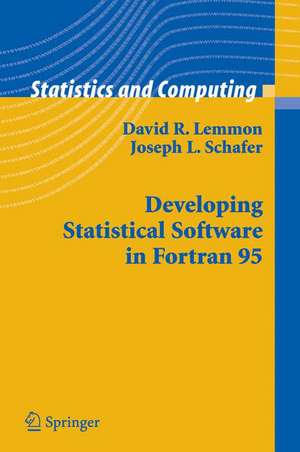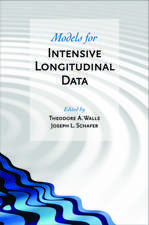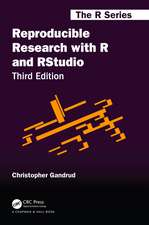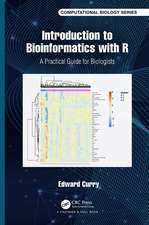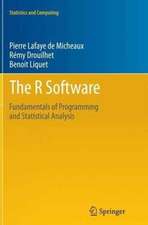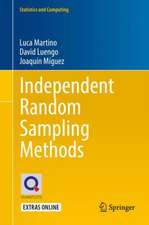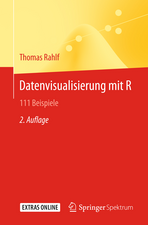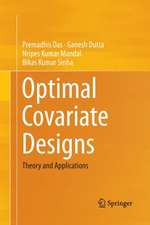Developing Statistical Software in Fortran 95: Statistics and Computing
Autor David R. Lemmon, Joseph L. Schaferen Limba Engleză Paperback – 6 mai 2005
Topics include how to:
Program in Fortran 95 using a pseudo object-oriented style
Write accurate and efficient computational procedures
Create console applications
Build dynamic-link libraries (DLLs) and Windows-based software components
Develop graphical user interfaces (GUIs)
Through detailed examples, readers are shown how to call Fortran procedures from packages including Excel, SAS, SPSS, S-PLUS, R, and MATLAB. They are even given a tutorial on creating GUIs for Fortran computational code using Visual Basic.NET.
This book is for those who want to learn how to create statistical applications quickly and effectively. Prior experience with a programming language such as Basic, Fortran or C is helpful but not required. More experienced programmers will learn new strategies to harness the power of modern Fortran and the object-oriented paradigm. This may serve as a supplementary text for a graduate course on statistical computing.
From the reviews:
"This book should be read by all statisticians, engineers, and scientists who want to implement an algorithm as a computer program. The book is the best introduction to programming that I have ever read. I value it as one of my important reference books in my personal library." Melvin J. Hinich for Techonmetrics, November 2006
"Overall, the book is well written and provides a reasonable introduction to the use of modern versions of Fortran for statistical computation. The real thrust of the book is building COM interfaces using Fortran, and it will no doubt be most useful to anyone who needs to build such interfaces." Journal of the American Statistical Association, June 2006
"The book is well written and is divided into chapters and sections which are coherent...Overall the book seems like a good resource for someone that already knows some dialect of FORTRAN and wants to learn a bit about what is new in FORTRAN 95..." Robert Gentleman for the Journal of Statistical Software, December 2006
Din seria Statistics and Computing
- 20%
 Preț: 753.99 lei
Preț: 753.99 lei -
 Preț: 228.21 lei
Preț: 228.21 lei - 20%
 Preț: 505.20 lei
Preț: 505.20 lei -
 Preț: 438.82 lei
Preț: 438.82 lei -
 Preț: 386.81 lei
Preț: 386.81 lei - 20%
 Preț: 1059.77 lei
Preț: 1059.77 lei -
 Preț: 426.73 lei
Preț: 426.73 lei - 20%
 Preț: 474.37 lei
Preț: 474.37 lei - 18%
 Preț: 1387.07 lei
Preț: 1387.07 lei -
 Preț: 433.53 lei
Preț: 433.53 lei -
 Preț: 208.58 lei
Preț: 208.58 lei - 20%
 Preț: 1174.26 lei
Preț: 1174.26 lei - 18%
 Preț: 959.32 lei
Preț: 959.32 lei - 15%
 Preț: 643.48 lei
Preț: 643.48 lei -
 Preț: 392.75 lei
Preț: 392.75 lei -
 Preț: 404.29 lei
Preț: 404.29 lei - 15%
 Preț: 640.06 lei
Preț: 640.06 lei - 20%
 Preț: 1454.73 lei
Preț: 1454.73 lei -
 Preț: 377.18 lei
Preț: 377.18 lei - 23%
 Preț: 652.31 lei
Preț: 652.31 lei - 15%
 Preț: 710.42 lei
Preț: 710.42 lei - 15%
 Preț: 695.85 lei
Preț: 695.85 lei - 20%
 Preț: 1276.86 lei
Preț: 1276.86 lei - 18%
 Preț: 1003.38 lei
Preț: 1003.38 lei - 15%
 Preț: 703.85 lei
Preț: 703.85 lei -
 Preț: 384.70 lei
Preț: 384.70 lei - 15%
 Preț: 606.17 lei
Preț: 606.17 lei - 15%
 Preț: 646.94 lei
Preț: 646.94 lei - 15%
 Preț: 589.02 lei
Preț: 589.02 lei - 18%
 Preț: 1117.99 lei
Preț: 1117.99 lei -
 Preț: 503.52 lei
Preț: 503.52 lei - 18%
 Preț: 735.38 lei
Preț: 735.38 lei - 15%
 Preț: 693.90 lei
Preț: 693.90 lei
Preț: 642.68 lei
Preț vechi: 756.09 lei
-15% Nou
Puncte Express: 964
Preț estimativ în valută:
122.98€ • 131.50$ • 102.54£
122.98€ • 131.50$ • 102.54£
Carte tipărită la comandă
Livrare economică 18 aprilie-02 mai
Preluare comenzi: 021 569.72.76
Specificații
ISBN-13: 9780387238173
ISBN-10: 0387238174
Pagini: 323
Ilustrații: XVI, 324 p.
Dimensiuni: 155 x 235 x 18 mm
Greutate: 0.48 kg
Ediția:2005
Editura: Springer
Colecția Springer
Seria Statistics and Computing
Locul publicării:New York, NY, United States
ISBN-10: 0387238174
Pagini: 323
Ilustrații: XVI, 324 p.
Dimensiuni: 155 x 235 x 18 mm
Greutate: 0.48 kg
Ediția:2005
Editura: Springer
Colecția Springer
Seria Statistics and Computing
Locul publicării:New York, NY, United States
Public țintă
ResearchCuprins
Motivation.- to Modern Fortran.- A Pseudo Object-Oriented Style.- Implementing Computational Routines.- Developing a Console Application.- Creating and Using Dynamic-Link Libraries.- Creating COM Servers.- Creating COM Clients.
Recenzii
From the reviews:
"This book should be read by all statisticians, engineers, and scientists who want to implement an algorithm as a computer program. The book is the best introduction to programming that I have ever read. I value it as one of my important reference books in my personal library." Melvin J. Hinich for Techonmetrics, November 2006
"Overall, the book is well written and provides a reasonable introduction to the use of modern versions of Fortran for statistical computation. The real thrust of the book is building COM interfaces using Fortran, and it will no doubt be most useful to anyone who needs to build such interfaces." Journal of the American Statistical Association, June 2006
"The book is well written and is divided into chapters and sections which are coherent...Overall the book seems like a good resource for someone that already knows some dialect of FORTRAN and wants to learn a bit about what is new in FORTRAN 95..." Robert Gentleman for the Journal of Statistical Software, December 2006
"The purpose of this book is to help statisticians, (theory and) application-oriented developers, and researchers who need statistical computer programs to write a good FORTRAN program for the first time. Since good programming style can be taught and learned, the authors try for their potential readers to get into the experience of developing FORTRAN applications as quick, painless and rewarding as possible." (Silvia Curteanu, Zentralblatt MATH, Vol. 1076, 2006)
"This book is designed to teach applied statisticians how to write reliable, maintainable and re-usable programs using modern Fortran, and how to access these programs from other software. … I heartily recommend this book to anyone wishing to develop modern statistical software in Fortran – even those with considerable experience will learn something from it. For anyone used to writing long subroutines in FORTRAN 77, itshould be considered compulsory. The style is engaging … and the use of statistical examples and exercises very helpful." (Len Thomas, Journal of Applied Statistics, Vol. 34 (3), 2007)
"Fortran is still unrivalled with respect to computing speed. … Its aim is rather to present instructions for writing good programs. … The text is written very readably. The explanations always take place along well-chosen example applications. The book makes undoubtedly a persuasive case for choosing Fortran for programming statistical software. … it offers enough suggestions and instructions for creating good programs that it is to be recommended to all who program statistically." (Rainer Schlittgen, Advances in Statistical Analysis, Vol. 91, 2007)
"This book should be read by all statisticians, engineers, and scientists who want to implement an algorithm as a computer program. The book is the best introduction to programming that I have ever read. I value it as one of my important reference books in my personal library." Melvin J. Hinich for Techonmetrics, November 2006
"Overall, the book is well written and provides a reasonable introduction to the use of modern versions of Fortran for statistical computation. The real thrust of the book is building COM interfaces using Fortran, and it will no doubt be most useful to anyone who needs to build such interfaces." Journal of the American Statistical Association, June 2006
"The book is well written and is divided into chapters and sections which are coherent...Overall the book seems like a good resource for someone that already knows some dialect of FORTRAN and wants to learn a bit about what is new in FORTRAN 95..." Robert Gentleman for the Journal of Statistical Software, December 2006
"The purpose of this book is to help statisticians, (theory and) application-oriented developers, and researchers who need statistical computer programs to write a good FORTRAN program for the first time. Since good programming style can be taught and learned, the authors try for their potential readers to get into the experience of developing FORTRAN applications as quick, painless and rewarding as possible." (Silvia Curteanu, Zentralblatt MATH, Vol. 1076, 2006)
"This book is designed to teach applied statisticians how to write reliable, maintainable and re-usable programs using modern Fortran, and how to access these programs from other software. … I heartily recommend this book to anyone wishing to develop modern statistical software in Fortran – even those with considerable experience will learn something from it. For anyone used to writing long subroutines in FORTRAN 77, itshould be considered compulsory. The style is engaging … and the use of statistical examples and exercises very helpful." (Len Thomas, Journal of Applied Statistics, Vol. 34 (3), 2007)
"Fortran is still unrivalled with respect to computing speed. … Its aim is rather to present instructions for writing good programs. … The text is written very readably. The explanations always take place along well-chosen example applications. The book makes undoubtedly a persuasive case for choosing Fortran for programming statistical software. … it offers enough suggestions and instructions for creating good programs that it is to be recommended to all who program statistically." (Rainer Schlittgen, Advances in Statistical Analysis, Vol. 91, 2007)
Textul de pe ultima copertă
Many books teach computational statistics. Until now, however, none has shown how to write a good program. This book gives statisticians, biostatisticians and methodologically-oriented researchers the tools they need to develop high-quality statistical software. Topics include how to
Program in Fortran 95 using a pseudo object-oriented style
Write accurate and efficient computational procedures
Create console applications
Build dynamic-link libraries (DLLs) and Windows-based software components
Develop graphical user interfaces (GUIs).
Through detailed examples, readers are shown how to call Fortran procedures from packages including Excel, SAS, SPSS, S-PLUS, R, and MATLAB. They are even given a tutorial on creating GUIs for Fortran computational code using Visual Basic.NET.
This book is for those who want to learn how to create statistical applications quickly and effectively. Prior experience with a programming language such as Basic, Fortran or C is helpful but not required. More experienced programmers will learn new strategies to harness the power of modern Fortran and the object-oriented paradigm. This may serve as a supplementary text for a graduate course on statistical computing.
David R. Lemmon is a Research Associate at The Methodology Center in The Pennsylvania State University's College of Health and Human Development. He holds a Ph.D. in Mechanical Engineering from the University of Cincinnati. His areas of previous work include finite element analysis, automobile crash simulation, and biomechanical modeling of the diabetic foot. Since 2001, he has served as the Center's Senior Statistical Programmer, managing the creation of new statistical software for research and education.
Joseph L. Schafer is Associate Professor in the Department of Statistics at The Pennsylvania State University and a Principal Investigator at The Methodology Center. He holds a Ph.D. in Statistics from Harvard University. His areas of research include statistical methods for missing values, analysis of longitudinal data, statistical computing and methodology for studies of substance-use prevention. He has served as a statistical consultant to numerous government agencies and has taught many workshops and short courses on topics related to missing data.
Program in Fortran 95 using a pseudo object-oriented style
Write accurate and efficient computational procedures
Create console applications
Build dynamic-link libraries (DLLs) and Windows-based software components
Develop graphical user interfaces (GUIs).
Through detailed examples, readers are shown how to call Fortran procedures from packages including Excel, SAS, SPSS, S-PLUS, R, and MATLAB. They are even given a tutorial on creating GUIs for Fortran computational code using Visual Basic.NET.
This book is for those who want to learn how to create statistical applications quickly and effectively. Prior experience with a programming language such as Basic, Fortran or C is helpful but not required. More experienced programmers will learn new strategies to harness the power of modern Fortran and the object-oriented paradigm. This may serve as a supplementary text for a graduate course on statistical computing.
David R. Lemmon is a Research Associate at The Methodology Center in The Pennsylvania State University's College of Health and Human Development. He holds a Ph.D. in Mechanical Engineering from the University of Cincinnati. His areas of previous work include finite element analysis, automobile crash simulation, and biomechanical modeling of the diabetic foot. Since 2001, he has served as the Center's Senior Statistical Programmer, managing the creation of new statistical software for research and education.
Joseph L. Schafer is Associate Professor in the Department of Statistics at The Pennsylvania State University and a Principal Investigator at The Methodology Center. He holds a Ph.D. in Statistics from Harvard University. His areas of research include statistical methods for missing values, analysis of longitudinal data, statistical computing and methodology for studies of substance-use prevention. He has served as a statistical consultant to numerous government agencies and has taught many workshops and short courses on topics related to missing data.
Caracteristici
Help a statistician, methodologist, or statistically-oriented researcher write a good Fortram program the first time Includes supplementary material: sn.pub/extras
